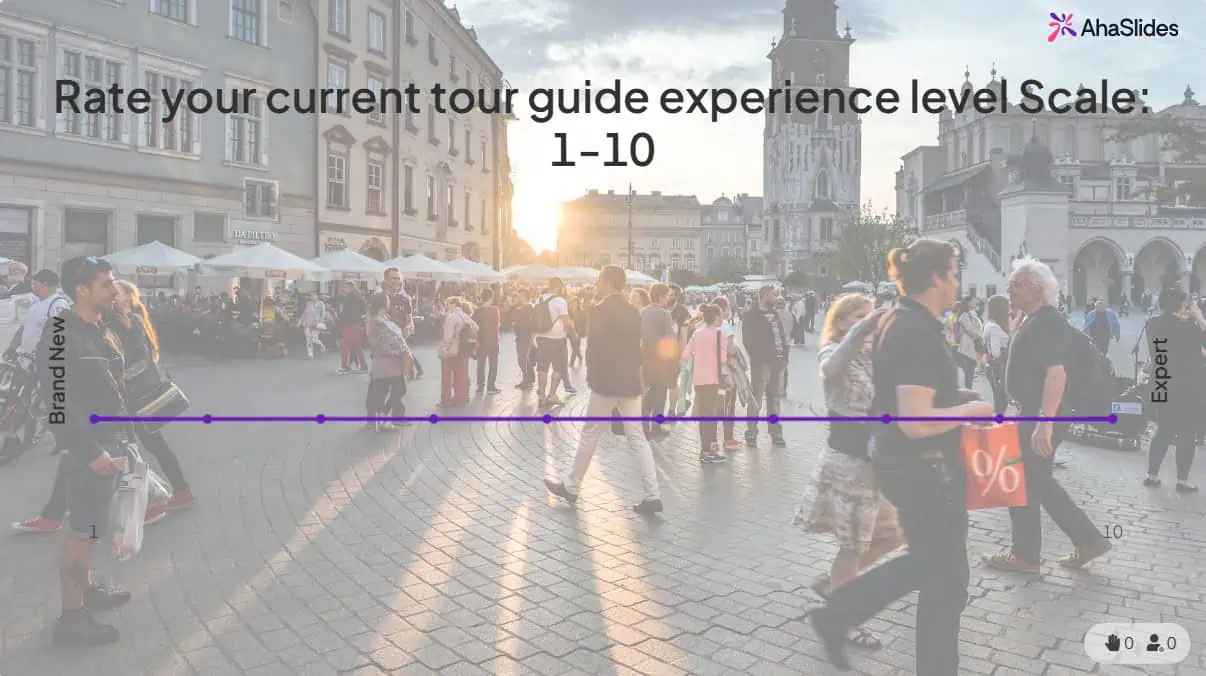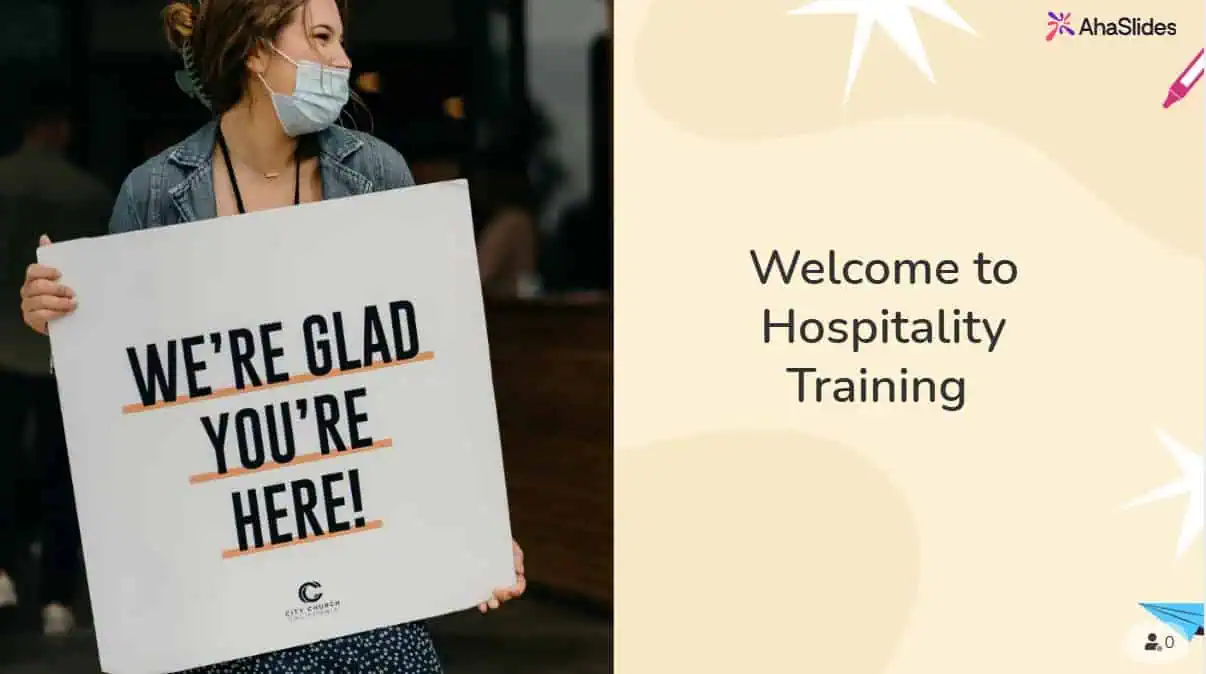Ang pagsasanay ay gumaganap ng isang mahalagang papel sa paghubog ng kalidad ng serbisyo, mga pamantayan sa kaligtasan, at pagpapanatili ng empleyado sa industriya ng mabuting pakikitungo. Gayunpaman, ang mga tradisyunal na pamamaraan—mga manu-manong session, mga materyal na nakabatay sa papel, at mga static na presentasyon—ay kadalasang nahihirapang makasabay sa mga hinihingi sa pagpapatakbo, umuusbong na mga kinakailangan sa pagsunod, at ang mabilis na turnover na karaniwan sa larangan.
Ang digital transformation sa pagsasanay ay hindi lamang tungkol sa modernisasyon; ito ay tungkol sa pagiging praktikal, pagkakapare-pareho, at mas mahusay na mga resulta. AhaSlides nag-aalok ng diskarteng nakaugat sa flexibility, interaksyon, at real-world application, na nagbibigay-daan sa mga team na matuto sa sarili nilang bilis gamit ang mga tool na sumusuporta sa pag-unawa, pagmuni-muni, at pakikipagtulungan.
- Mga Hamon ng Tradisyunal na Pagsasanay sa Pagtanggap ng Bisita
- Mga Real-World Use Case sa Hospitality Training
- Pangkapaligiran at Operasyong Mga Nadagdag mula sa Pagiging Walang Papel
- Pagpapatibay ng Pagpapanatili sa pamamagitan ng Spaced Repetition at Multimedia
- Pagsubaybay sa Pag-unlad at Pagtugon sa Mga Pamantayan sa Pagsunod
- Mga Pangunahing Benepisyo para sa Mga Koponan sa Pagtanggap ng Bisita
- Mga Praktikal na Tip para Masulit ang Digital Hospitality Training
- Konklusyon: Mas Matalinong Pagsasanay para sa isang Demanding na Industriya
- Mga template para makapagsimula ka
Mga Hamon ng Tradisyunal na Pagsasanay sa Pagtanggap ng Bisita
Ang pagsasanay sa hospitality ay dapat balansehin ang accessibility, katumpakan, at cost-efficiency. Gayunpaman, maraming mga hadlang ang nananatili:
- Cost-Intensive: Ayon kay Magasin sa Pagsasanay (2023), ang mga kumpanya ay gumastos ng isang average ng $954 bawat empleyado sa mga programa sa pagsasanay noong nakaraang taon—isang makabuluhang pamumuhunan, lalo na sa mga kapaligirang may mataas na turnover.
- Pagkagambala sa mga Operasyon: Ang pag-iskedyul ng mga personal na session ay kadalasang nakakasagabal sa mga pinakamaraming oras ng serbisyo, na nagpapahirap sa pagbibigay ng pare-pareho, walang patid na pagsasanay.
- Kakulangan ng Uniformity: Maaaring mag-iba ang kalidad ng pagsasanay depende sa facilitator, na humahantong sa hindi pare-parehong mga resulta ng pag-aaral sa mga koponan.
- Regulatory Pressure: Ang mga bagong pamantayan sa pagsunod ay nangangailangan ng patuloy na pag-update, at ang mga manu-manong system ay kadalasang kulang sa pagsubaybay at dokumentasyon.
- Mataas na Turnover: Ang National Restaurant Association (2023) ay nag-uulat ng mga rate ng turnover sa pagitan 75% at 80% taun-taon, ginagawang kailangan at magastos ang patuloy na muling pagsasanay.
Binibigyang-diin ng mga isyung ito ang pangangailangan para sa isang mas madaling ibagay, nasusukat, at nasusukat na diskarte sa pagsasanay sa mabuting pakikitungo.

Mga Real-World Use Case sa Hospitality Training
Ang tagumpay ng interactive na pagsasanay ay nakasalalay hindi lamang sa mga tool ngunit sa kung paano ito inilalapat. Nasa ibaba ang ilang karaniwan at epektibong kaso ng paggamit:
- Mga Icebreaker at Pagpapakilala ng Koponan
Ang mga word cloud at poll ay tumutulong sa mga bagong hire na mabilis na kumonekta sa mga miyembro ng team at kultura ng kumpanya, na nagtatakda ng positibong tono mula sa simula. - Mga Pagsusuri ng Kaalaman Sa Panahon ng Mga Sesyon
Ang mga pana-panahong pagsusulit ay sumusukat sa pag-unawa at nagbibigay ng agarang feedback—angkop para sa pagpapatibay ng mga pangunahing punto sa kaligtasan, serbisyo, o mga module ng patakaran. - Mga Pinadaliang Talakayan at Pagbabahaginan ng Karanasan
Ang anonymous na Q&A at mga tool sa brainstorming ay lumilikha ng mga ligtas na espasyo para sa pagbabahagi ng mga ideya, paglabas ng mga tanong, o pagrepaso sa mga senaryo ng serbisyo mula sa mga totoong pagbabago. - Pagpapatibay ng Patakaran at Pamamaraan
Nakakatulong ang pagtutugma ng mga aktibidad o gawain sa pagkakategorya na gawing mas madaling lapitan at hindi malilimutan ang kumplikado o siksik na impormasyon ng patakaran. - Session Debriefs at Reflections
Ang mga prompt ng feedback sa pagtatapos ng session at bukas na mga botohan ay humihikayat ng pagmuni-muni, na nagbibigay sa mga tagapagsanay ng mahahalagang insight sa kung ano ang tumutugon at kung ano ang nangangailangan ng pagpapatibay.
Nakakatulong ang mga application na ito na i-bridge ang agwat sa pagitan ng mga digital na tool at praktikal, on-the-floor learning.
Pangkapaligiran at Operasyong Mga Nadagdag mula sa Pagiging Walang Papel
Ang pagsasanay na nakabatay sa papel ay nangingibabaw pa rin sa maraming lugar ng trabaho, lalo na sa panahon ng onboarding. Ngunit ito ay may mga kakulangan sa kapaligiran at logistik. Ayon sa Ahensiya sa Proteksiyon ng Kapaligiran (2021), papel na account para sa mahigit 25% ng basura sa landfill sa Estados Unidos.
Ang pag-digitize ng pagsasanay sa AhaSlides ay nag-aalis ng pangangailangan para sa mga printout at binder, na binabawasan ang epekto sa kapaligiran at ang mga gastos ng mga pisikal na materyales. Tinitiyak din nito na ang mga update sa content ng pagsasanay ay maaaring mailunsad kaagad—walang kinakailangang muling pag-print.

Pagpapatibay ng Pagpapanatili sa pamamagitan ng Spaced Repetition at Multimedia
Ang mga pag-aaral sa cognitive psychology ay matagal nang nagpakita ng mga benepisyo ng spaced repetition—pagsusuri ng impormasyon sa mga spaced interval upang mapahusay ang memory retention (Vlach, 2012). Ang diskarteng ito ay naka-embed sa mga daloy ng pagsasanay ng AhaSlides, na tumutulong sa mga mag-aaral na mapanatili ang pangunahing impormasyon nang mas epektibo sa paglipas ng panahon.
Makakadagdag dito ang mga format ng multimedia—mga larawan, diagram, maiikling video—na ginagawang mas madaling natutunaw ang abstract o teknikal na impormasyon. Para sa mga koponan na ang unang wika ay maaaring hindi Ingles, ang mga visual na suporta ay maaaring maging kapaki-pakinabang lalo na sa pagpapahusay ng pag-unawa.
Pagsubaybay sa Pag-unlad at Pagtugon sa Mga Pamantayan sa Pagsunod
Ang isa sa mga mas kumplikadong aspeto ng pagsasanay sa mabuting pakikitungo ay ang pagtiyak ng pagsunod: pagkumpirma na ang bawat miyembro ng koponan ay nakumpleto ang kinakailangang pagsasanay, nakuha ang pangunahing impormasyon, at nananatiling up-to-date sa mga pagbabago.
Nag-aalok ang AhaSlides ng built-in na analytics na nagbibigay-daan sa mga trainer at manager na subaybayan ang pagkumpleto ng module, pagganap ng pagsusulit, at mga antas ng pakikipag-ugnayan. Pinapasimple ng awtomatikong pag-uulat ang paghahanda sa pag-audit at tinitiyak na walang maiiwan, partikular na mahalaga sa mga industriyang may mahigpit na mga regulasyon sa kaligtasan o pangangasiwa ng pagkain.
Mga Pangunahing Benepisyo para sa Mga Koponan sa Pagtanggap ng Bisita
- Budget-Concious: Bawasan ang pag-asa sa mga panlabas na tagapagsanay at materyales habang pinapabuti ang pagkakapare-pareho.
- Nasusukat para sa Anumang Laki ng Koponan: Sanayin ang mga bagong hire o buong sangay na walang logistical bottleneck.
- Kalidad ng Unipormeng Pagsasanay: Ihatid ang parehong materyal sa bawat mag-aaral, pinapaliit ang mga puwang sa pag-unawa.
- Minimal na Pagkagambala: Maaaring kumpletuhin ng mga tauhan ang pagsasanay sa paligid ng kanilang mga shift, hindi sa mga oras ng tugatog.
- Mas Mataas na Rate ng Pagpapanatili: Ang pag-uulit at interaktibidad ay sumusuporta sa pangmatagalang pag-aaral.
- Pinahusay na Pagsubaybay sa Pagsunod: Tinitiyak ng pinasimpleng pagsubaybay sa pag-unlad na palagi kang handa sa pag-audit.
- Naka-streamline na Onboarding: Nakakatulong ang mga structured, nakakaengganyong learning path ng mga bagong empleyado na maging produktibo nang mas maaga.
Mga Praktikal na Tip para Masulit ang Digital Hospitality Training
- Magsimula sa Mga Core Compliance Module: Unahin ang kalusugan, kaligtasan, at legal na mahahalagang bagay.
- Gumamit ng Mga Pamilyar na Sitwasyon: I-customize ang content na may mga halimbawang nakakaharap ng iyong team araw-araw.
- Isama ang Mga Biswal: Ang mga larawan at diagram ay nakakatulong na tulay ang mga puwang sa wika at mapabuti ang pag-unawa.
- Space Out Learning: Gumamit ng mga paalala at refresher upang unti-unting palakasin ang mga konsepto.
- Kilalanin ang Pag-unlad: I-highlight ang mga nangungunang mag-aaral upang hikayatin ang malusog na kompetisyon at pagganyak.
- Tailor ayon sa Tungkulin: Magdisenyo ng hiwalay na mga daanan para sa front-of-house at back-of-house staff.
- Patuloy na Update: Regular na i-refresh ang nilalaman upang ipakita ang mga pana-panahong pagbabago o mga bagong patakaran.
Konklusyon: Mas Matalinong Pagsasanay para sa isang Demanding na Industriya
Ang epektibong pagsasanay sa mabuting pakikitungo ay hindi tungkol sa pag-tick ng mga kahon. Ito ay tungkol sa pagbuo ng mga may kakayahan at kumpiyansa na mga koponan na nauunawaan ang "bakit" sa likod ng kanilang trabaho, hindi lamang ang "paano."
Sa AhaSlides, ang mga organisasyon ng mabuting pakikitungo ay maaaring gumamit ng isang mas adaptive, inklusibo, at epektibong diskarte sa pagsasanay—isa na gumagalang sa oras ng mga empleyado, sumusuporta sa mas mahusay na serbisyo, at nakakatugon sa mga hinihingi ng isang mabilis na pagbabago ng industriya.
Mga template para makapagsimula ka

Pagsasanay sa onboard

Onboard na pagsusuri
Mga sanggunian
- Ahensya sa Pangangalaga sa Kapaligiran. (2021). Sustainable Materials Management Web Academy. https://www.epa.gov/smm/sustainable-materials-management-web-academy
- National Restaurant Association. (2023). Estado ng Industriya ng Restaurant 2023. https://go.restaurant.org/rs/078-ZLA-461/images/SOI2023_Report_NFP_embargoed.pdf
- Magasin sa Pagsasanay. (2023). 2023 Ulat sa Industriya ng Pagsasanay. https://trainingmag.com/2023-training-industry-report/
- Vlach, HA (2012). Pamamahagi ng pag-aaral sa paglipas ng panahon: Ang epekto ng espasyo sa pagkuha at paglalahat ng mga konsepto ng agham ng mga bata. Sikolohikal Science. https://www.ncbi.nlm.nih.gov/pmc/articles/PMC3399982/
